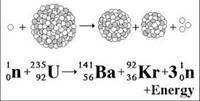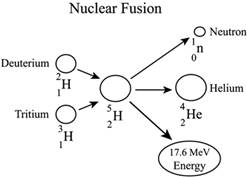
Concept explainers
Interpretation:
The type of the reactions involved in change in the nucleus of an atom needs to be determined.
Concept introduction:
Nuclear reactions are main type of reactions which changes the nucleus from its original form. These reactions cause changes in the subatomic particles mainly the number of protons and the number of neutrons.
Answer to Problem 84A
There are mainly four types of reactions changing the nucleus of an atom.
- Nuclear fission.
- Nuclear fusion.
- Nuclear decay.
- Transmutation.
Explanation of Solution
- Nuclear fission − The first nuclear reaction is fission. The word fission explains the breakdown in the reaction. A heavy nucleus split or breakdown into two or more similar nuclei. These reactions are exothermic in nature.

- Nuclear fusion − The second one reaction is the joining of nuclei of atoms. In this reaction, two simple or more atoms comes together and form a heavy nucleus. The fusion reaction of light elements can be highly exothermic in nature.

- Nuclear decay - The decay means that, in these reactions mainly the radiation occurs. There are three important radioactive reactions known as alpha, beta, and gamma decay. The number of protons or neutrons changes in these decays. Nuclear decay almost always involves large energy release in the form of radiation.
- Transmutation − This reaction is just reverse of the nuclear decay type reaction. These types of reactions are generally artificial process. They are non-spontaneous process. Transmutation involves increasing the mass of nuclei.
The examples are represented as follows:
a decay − 92U238→90Th234+ 2He4
ß decay − 53I131 →54Xe131 + -1e0
ϒdecay- 90Th234→90Th234 + ϒ
The nuclear reaction changes the stability as well as property of the product, these reactions are very helpful for the industrial level and for the research field but some reactions are harmful for the nature.
Chapter 4 Solutions
Glencoe Chemistry: Matter and Change, Student Edition
Additional Science Textbook Solutions
CHEMISTRY-TEXT
Chemistry: The Central Science (13th Edition)
Essential Organic Chemistry (3rd Edition)
Organic Chemistry (9th Edition)
General, Organic, and Biological Chemistry (3rd Edition)
Organic Chemistry (8th Edition)
 ChemistryChemistryISBN:9781305957404Author:Steven S. Zumdahl, Susan A. Zumdahl, Donald J. DeCostePublisher:Cengage Learning
ChemistryChemistryISBN:9781305957404Author:Steven S. Zumdahl, Susan A. Zumdahl, Donald J. DeCostePublisher:Cengage Learning ChemistryChemistryISBN:9781259911156Author:Raymond Chang Dr., Jason Overby ProfessorPublisher:McGraw-Hill Education
ChemistryChemistryISBN:9781259911156Author:Raymond Chang Dr., Jason Overby ProfessorPublisher:McGraw-Hill Education Principles of Instrumental AnalysisChemistryISBN:9781305577213Author:Douglas A. Skoog, F. James Holler, Stanley R. CrouchPublisher:Cengage Learning
Principles of Instrumental AnalysisChemistryISBN:9781305577213Author:Douglas A. Skoog, F. James Holler, Stanley R. CrouchPublisher:Cengage Learning Organic ChemistryChemistryISBN:9780078021558Author:Janice Gorzynski Smith Dr.Publisher:McGraw-Hill Education
Organic ChemistryChemistryISBN:9780078021558Author:Janice Gorzynski Smith Dr.Publisher:McGraw-Hill Education Chemistry: Principles and ReactionsChemistryISBN:9781305079373Author:William L. Masterton, Cecile N. HurleyPublisher:Cengage Learning
Chemistry: Principles and ReactionsChemistryISBN:9781305079373Author:William L. Masterton, Cecile N. HurleyPublisher:Cengage Learning Elementary Principles of Chemical Processes, Bind...ChemistryISBN:9781118431221Author:Richard M. Felder, Ronald W. Rousseau, Lisa G. BullardPublisher:WILEY
Elementary Principles of Chemical Processes, Bind...ChemistryISBN:9781118431221Author:Richard M. Felder, Ronald W. Rousseau, Lisa G. BullardPublisher:WILEY





